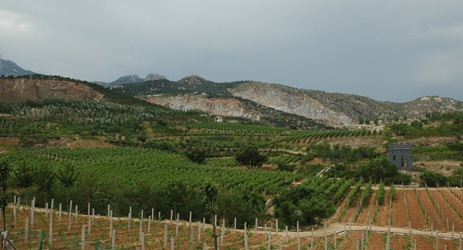Demei's View - Wine Communication from a Chinese Winemaker
Although China has the fourth largest vineyard area in the world, the majority of wine grapes - especially European species (Vitis vinifera) - are mainly planted in northern China.
In these areas, vines need to be buried under earth every winter. The lower the temperature is, the deeper the vines are buried. Then from the end of March to early April, wine growers in these regions will dig out the vines and bind them onto the pergolas whilst the vines begin to germinate.
However, just like the other regions, the weather is unstable during the seasonal change, and growers have to face possible wind damage and freezing injury.
Two weeks ago, a cold air front from Siberia travelled from west to east, and swept over most of the wine regions in China.

1 Northern Xinjiang: Heavy snow hit this area last week, but the vines in this region haven’t sprouted yet, so the drop in temperature may not affect the grapes too much this time. However, early sprouting trees in the area were not quite as lucky as the vines. (Image 1 and 2)
2 Southern Xinjiang: The temperature rise in southern Xinjiang begins earlier than other areas in northern China, and the vines are generally starting to sprout now.
Part of the vineyards in this region are suffering from freezing injury because of two consecutive sub-zero spells and gales since mid-April. In the low-lying vineyards, wine growers use some ancient methods to fight against the frost (Image 3 and 4). The second time temperature drop was accompanied by a gale. The dust brought by the strong wind prevented the cold air sinking (Image 5), but the gale also caused mechanical damage to the vines (Image 6). Although the low temperature was similar to the first temperature drop, the damage caused by the freezing was lighter than the first time.
3 Gansu: The cold air has approached the southeast along the low-lying Gansu. It was partly snowing in Gansu last week and the weather affected vines which had already begun to germinate. (Image 7)
4 Ningxia: The cold air reached Ningxia on Thursday (24 April). The wind strength reduced in this open area, and the speed of the cold air also slowed down. With the obstruction of the north-south Helan Mountain, there was sleet in Ningxia. The drop in temperature may not disturb this region too much if the temperature can rise back quickly in the near future. (Image 8 and 9)
Floating dust appeared in Shanxi, Hebei and Beijing (Image 10), and some areas have scattered showers – it was actually rainwater carrying soil.
Northern China has a typically continental monsoon climate. Severe cold air from Siberia dominates this area in the winter with prevailing northwest wind; hot and humid air from China’s southeast coastal areas heads all the way up in the summer and brings rain to the north. Spring and autumn are the seasons with alternating cold and warmth. Especially in spring, plants often face damage from cold spells in later spring when they have just sprouted. This is probably one of the main reasons for the Chinese wine industry not having developed more extensively throughout the course of history.
Translated by Nina Fan Feng / 冯帆
All rights reserved by Future plc. No part of this publication may be reproduced, distributed or transmitted in any form or by any means without the prior written permission of Decanter.
Only Official Media Partners (see About us) of DecanterChina.com may republish part of the content from the site without prior permission under strict Terms & Conditions. Contact china@decanter.com to learn about how to become an Official Media Partner of DecanterChina.com.





Comments
Submit